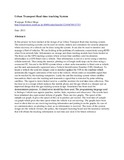| dc.contributor.author | Wanjugu, Wilfred Mugo | |
| dc.date.accessioned | 2013-03-14T09:18:46Z | |
| dc.date.issued | 2011 | |
| dc.identifier.citation | Master of Science in Information Systems | en |
| dc.identifier.uri | http://erepository.uonbi.ac.ke:8080/xmlui/handle/123456789/13755 | |
| dc.description.abstract | In this project we have looked at the design of an Urban Transport Real time tracking
system. The current tracking systems can be used on trucks, trailers and containers for
security purposes where recovery of a vehicle can be done using the system. It can also
be used to monitor and manage a fleet of vehicles. We are looking at the problem of
continuous connectivity using RFID when Gsm network fails.
Information on storage and three tracking models have been looked at. The three are the
GPS tracking systems where at least four satellites send localization information to a GPS
fitted onto a vehicle. That information is sent to a server using a wireless cellular
network. Then using the internet, plotting on a Google earth map can be done using a
connected PC.
Second is the RFID system where a silent radio transmitter is fitted onto a vehicle and the
unit automatically registered into a Vehicle Identification Number (VIN) Database. To
locate a vehicle the system's unique code is matched against the VIN in the database
which automatically triggers activation of the unit in the vehicle, which emits an
inaudible signal that can be tracked by the tracking computers.
Lastly the satellite tracking system where satellite transmitters fitted onto the tracking
task transmits a signal that is detected by polar orbiting satellites. The signal is down
linked (sent to a satellite modem) for real time data collection. This has lead us to a
design which replaces the mobile phone and the gps which is a cheaper and an improved
design than the gps tracking system design.
Simulation has been used for demonstration purposes. A client/server model has been
used. The programming language used is Netlogo-l which uses agents (patches, turtles,
links, reporters and observers).
The results have been tabulated also represented inform of graphs. There are two graphs.
The speed of the sample-car graph. It gives the speed of the car in patches per second.
The wait time of sample-car graph which gives the time spent when the vehicle was not
moving. The graphs have been used to show that we are receiving tracking information
and putting it on the graphs. In case of no communication, no plotting is done as no
information is received.
The users of the system design are the vehicle owners, the police, the transport licensing
board and the insurance industry that will obtain the tracking information in real time and
store it for future reference | en |
| dc.description.sponsorship | University of Nairobi | en |
| dc.language.iso | en | en |
| dc.publisher | University of Nairobi | en |
| dc.subject | Urban Transport | en |
| dc.subject | Real time tracking System | en |
| dc.subject | Tracking System | en |
| dc.title | Urban Transport Real time tracking System | en |
| dc.type | Thesis | en |
| local.publisher | School of Computing and Informatics | en |

